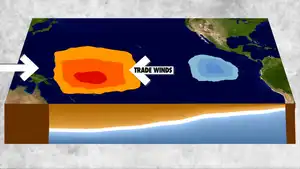How Does El Nino Cause Drought in South Africa?

What exactly is El Nino?
El Nino is a climate phenomenon that occurs in the Pacific Ocean and is distinguished by unusually warm surface waters.
What is the distinction between La Nia and El Nino?
El Niño represents the warm phase of the ENSO cycle where above-average sea-surface temperatures develops periodically across the east-central equatorial Pacific whereas La Niña represents the cooling phase of the ENSO cycle where periodic cooling of sea-surface temperatures occurs across the east-central equatorial Pacific.
What is the main cause of El Nino?
An El Nino event happens when surface water in the equatorial Pacific warms above average and east winds blow weaker than usual.
How many times does El Nino occur in a decade?
El Nino typically occur every 3 to 5 years.
What are the effects of El Nino?
1. Severe drought and associated food insecurity.
2. Floods.
3. Continuous rainfall.
4. High temperature rises.
5. Political and social unrest.
6. Death of aquatic species and sea birds
7. Health problems, including disease outbreaks, malnutrition, heat stress and respiratory diseases.
8. Occurrence of Hurricanes and Typhoons
How does El Nino cause drought in South Africa?
The high temperatures associated with El Nino cause less rain to fall, which is quickly followed by decreased river discharges due to high levels of evaporation. Lower discharges also have a direct impact on reservoir water storage levels. If there is a consistent lack of water feeding the reservoirs, this will unavoidably lead to water shortages and, as a result, drought.
How can farmers cope with the effects of El Nino?
1. Adopt the installation of mulch (plastic or straw)
2. Plant early-maturing and drought resistant crops
3. Expand water storage capacities




